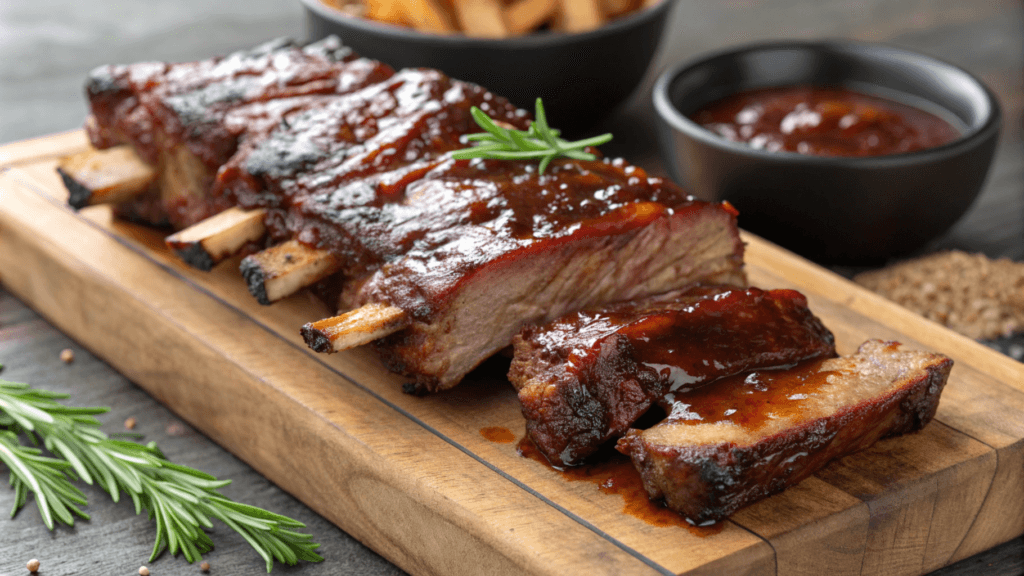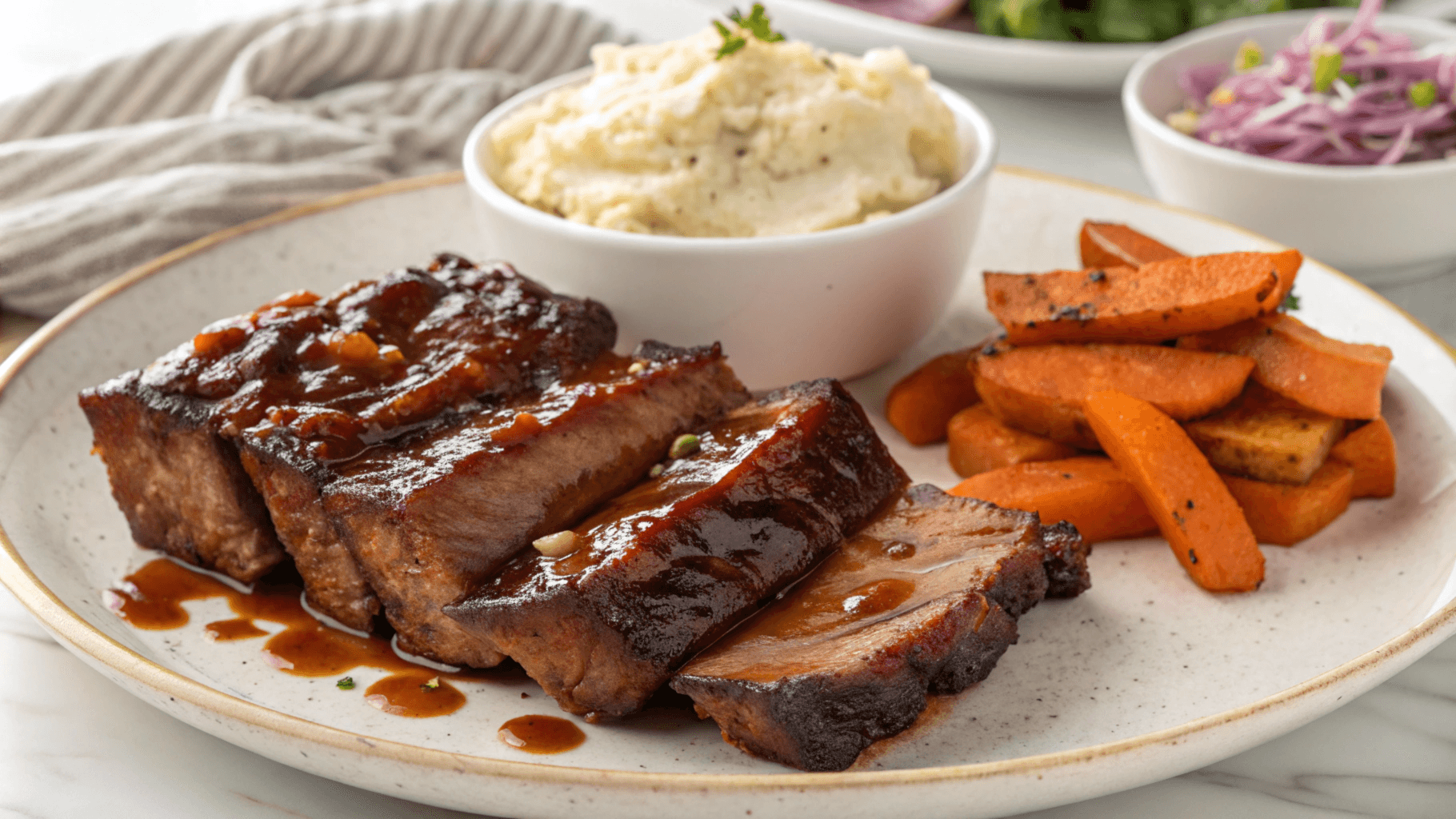Who doesn’t love a tender, juicy beef rib? Whether you’re a seasoned chef or a weekend warrior in the kitchen, knowing how to cook beef ribs in the oven is a game-changer. It’s a simple, effective way to get that melt-in-your-mouth experience without needing a grill or smoker. And the best part? It’s a set-it-and-forget-it method that leads to beautifully cooked ribs, whether you’re cooking for one or a crowd.
In this guide, we’re going to walk you through every step of the process, from selecting the right cut of beef to solving common problems that might pop up during cooking. So, grab your apron, and let’s dive into the world of oven-cooked beef ribs!
Why Cooking Beef Ribs in the Oven is a Game Changer
When you think of beef ribs, the first thing that probably comes to mind is grilling or smoking. But cooking them in the oven has a few distinct advantages. In fact, for most home cooks, the oven is a far easier and more reliable method to achieve perfectly cooked ribs. Here’s why:
Advantages of Oven-Cooked Beef Ribs
- Consistent Heat: Your oven provides a consistent heat source, which is key to cooking beef ribs evenly and thoroughly. Unlike grilling, where you might get hot spots or flare-ups, the oven ensures your ribs cook evenly, with a controlled temperature.
- No Need for a Grill or Smoker: Not everyone has a grill or smoker at home, and that’s okay. The oven works as a perfect alternative. You can achieve that delicious, caramelized exterior and tender interior that we all crave, without stepping outside.
- Hands-Off Cooking: One of the best things about oven cooking is that it’s low maintenance. Once you get the ribs in the oven, you can focus on preparing side dishes, setting the table, or even taking a breather while they slowly cook to perfection.
So, what are we waiting for? It’s time to bring out the beef ribs and start cooking!
Types of Beef Ribs and How to Choose the Right Cut
When it comes to cooking beef ribs, choosing the right cut is key. Not all beef ribs are created equal. You’ll find different types of ribs, each with its own texture, flavor, and ideal cooking method. Let’s break down the two most common cuts:
Back Ribs vs. Short Ribs: What’s the Difference?
- Back Ribs (or Rib Ribs): These are the ribs most commonly associated with barbecue. They’re the ribs that sit atop the beef ribeye, hence the name. Back ribs have less meat compared to short ribs, but the meat is tender and flavorful. When cooked properly, back ribs offer a satisfying bite with a great balance of fat and lean meat.
- Short Ribs: Short ribs, on the other hand, come from the plate section of the cow and are much meatier than back ribs. They have a higher fat content, making them ideal for slow cooking methods like braising or roasting. The extra fat and marbling in short ribs give them a rich, melt-in-your-mouth texture. While short ribs require a longer cooking time, they’re perfect for an oven-cooked meal that falls off the bone.
Both cuts are delicious, but they require different approaches when cooking. Back ribs are better suited for shorter roasting times with a crispy exterior, while short ribs benefit from a long, slow roast to break down the fat and make them tender.
Choosing Between Bone-In and Boneless Beef Ribs
Now, there’s another debate to settle: bone-in versus boneless beef ribs. Each has its perks, so let’s weigh the options.
- Bone-In Ribs: The bone-in variety is the traditional choice for beef ribs. The bone adds flavor to the meat and helps keep it moist during cooking. Plus, you get that satisfying experience of gnawing on the bone (if that’s your thing). Bone-in ribs are great for long, slow roasting, as the bones help regulate the cooking process and retain heat.
- Boneless Ribs: Boneless beef ribs are a little more convenient. They cook faster than bone-in ribs, and there’s no need to worry about gnawing around bones. Boneless ribs are often more versatile, making them a good choice if you want to slice the meat for sandwiches or serve them in a stew. However, they might not have as much depth of flavor as bone-in cuts, so seasoning becomes even more important.
At the end of the day, the choice between bone-in and boneless depends on personal preference and the type of meal you’re preparing. Bone-in ribs are classic for a reason, but boneless ribs offer convenience and faster cooking times.
Essential Preparation Tips for Perfect Beef Ribs in the Oven
Once you’ve selected the right cut of beef ribs, it’s time to prep them for cooking. While beef ribs are naturally flavorful, proper seasoning and preparation will make a big difference in the final outcome. Here are a few tips to ensure your ribs are prepared perfectly before they hit the oven.
How to Season Beef Ribs for Maximum Flavor
Seasoning your beef ribs is crucial to bringing out their best flavor. While you could simply use salt and pepper, there’s a whole world of seasoning options that can take your ribs to the next level.
- Dry Rubs: A dry rub is a great way to infuse flavor into your ribs without making them too messy. You can create a custom dry rub with a mix of brown sugar, paprika, garlic powder, onion powder, black pepper, and cayenne pepper for some heat. Dry rubs form a beautiful crust on the ribs as they cook, sealing in the juices.
- Marinades: If you have time, marinating your ribs can add depth of flavor. A marinade with ingredients like soy sauce, Worcestershire sauce, garlic, and herbs will tenderize the meat while adding savory flavors. Let the ribs marinate for at least 2 hours (or overnight for maximum flavor absorption).
Marinating vs. Dry Rub: Which is Better for Oven-Cooked Ribs?
Both marinating and dry rubbing can work well for oven-cooked beef ribs, but each method has its advantages.
- Marinating works great for adding a more intense flavor, especially if you’re using ingredients like citrus or vinegar that can tenderize the meat. The downside is that it takes a bit more time and can make the ribs a bit more slippery when cooking.
- Dry Rubs, on the other hand, are the perfect solution if you’re short on time and still want a punch of flavor. They create a delicious crust around the ribs and are easy to apply.
For oven cooking, I’d recommend using a dry rub if you want a crispy, flavorful exterior. But if you’re in the mood for more complex flavors, marinating is your best bet.
How Long to Let Beef Ribs Rest Before Cooking
Before you get cooking, it’s essential to let the beef ribs rest at room temperature for at least 30 minutes. This allows the meat to cook more evenly. If the ribs are too cold when they hit the oven, they’ll take longer to cook and may result in uneven cooking. Allowing the meat to rest before cooking helps ensure a more consistent cook throughout.

Perfecting Your Meal with Sides, Sauces, and Pairings
Now that you’ve perfected the art of cooking beef ribs in the oven, it’s time to elevate your meal even further. Beef ribs are rich, flavorful, and hearty, so pairing them with the right sides, sauces, and beverages is key to creating a balanced and unforgettable dining experience. Let’s take a look at the best ways to complement your oven-cooked ribs.
Best Sides to Complement Oven-Cooked Beef Ribs
When you’ve got tender, juicy beef ribs on your plate, the sides should be just as satisfying. You’ll want to balance out the rich and hearty nature of the ribs with something light, fresh, and flavorful. Here are some perfect side options to consider:
1. Roasted Vegetables
Roasted vegetables are always a win when paired with beef ribs. The natural sweetness of roasted carrots, parsnips, and sweet potatoes complements the savory richness of the meat. Toss your veggies with olive oil, salt, pepper, and a few herbs like rosemary or thyme, then roast them at the same time as your ribs. The result? Crispy, caramelized edges that add texture and flavor to your plate.
2. Creamy Mashed Potatoes
What’s a hearty meat dish without mashed potatoes? Creamy, buttery mashed potatoes make the perfect base for soaking up any juicy rib drippings. You can even add garlic, chives, or Parmesan for extra flavor. The smooth texture contrasts beautifully with the meaty, crispy ribs.
3. Coleslaw
For a refreshing contrast to the richness of the ribs, serve up a tangy coleslaw. The crunchy cabbage, carrots, and dressing provide a cool, crisp element to balance the flavors. You can make it creamy or vinaigrette-based, depending on your preference. It’s a great way to cut through the richness of the beef and keep the meal light and vibrant.
4. Grilled Corn on the Cob
Nothing beats the simplicity of grilled corn on the cob when paired with beef ribs. The sweetness of the corn works wonders against the smoky, savory ribs, and it’s perfect for summer barbecues or cozy dinners alike. Don’t forget to slather some butter on the corn and sprinkle it with a little chili powder or paprika for extra flavor.
5. Sautéed Greens (Spinach, Kale, or Swiss Chard)
Add some greens to the plate with sautéed spinach, kale, or Swiss chard. These greens provide a slightly bitter contrast to the richness of the beef and can be sautéed with garlic and olive oil for an aromatic touch. Plus, they’re packed with nutrients, making them a healthy addition to the meal.
Sauces and Glazes That Bring Out the Best in Beef Ribs
No beef rib experience is complete without a delicious sauce or glaze to complement the rich flavors of the meat. Whether you prefer sweet, tangy, spicy, or savory, there’s a sauce that will elevate your beef ribs. Here are a few options to consider:
1. Barbecue Sauce
Barbecue sauce is the go-to choice for many when it comes to beef ribs. The smoky sweetness pairs perfectly with the beef, adding layers of flavor. Whether you go for a classic Kansas City-style sweet sauce or a tangy vinegar-based Carolina sauce, it’s hard to go wrong. Brush the sauce on during the last 10-15 minutes of cooking to let it caramelize on the ribs, creating a glossy, flavorful finish.
2. Garlic Butter Sauce
For a rich and indulgent sauce, look no further than garlic butter. Made with fresh garlic, butter, and herbs like parsley, this sauce adds a luxurious, aromatic touch to your ribs. Drizzle it over the meat just before serving for a melt-in-your-mouth experience.
3. Chimichurri Sauce
If you prefer something fresh and herbaceous, chimichurri is a fantastic option. This Argentine sauce, made with parsley, garlic, vinegar, olive oil, and red pepper flakes, offers a tangy and slightly spicy flavor that cuts through the richness of the beef. It’s the perfect complement if you’re looking for something a little lighter and more vibrant.
4. Honey Mustard Glaze
A honey mustard glaze strikes a beautiful balance between sweet and tangy, with just enough acidity to pair wonderfully with beef. Combine honey, Dijon mustard, and a little bit of lemon juice to create this sticky, glossy glaze. Brush it on during the last stage of cooking for a sweet finish that will have everyone asking for the recipe.
5. Teriyaki Sauce
For a bit of an Asian twist, you can glaze your beef ribs with a homemade teriyaki sauce. The soy sauce, honey, and ginger bring umami and sweetness that pair beautifully with the savory beef. Plus, it adds a nice shiny coat that looks as good as it tastes.
Wine, Beer, and Beverage Pairings for Beef Ribs
Choosing the right drink to accompany your beef ribs can make a world of difference in the dining experience. With the rich, bold flavors of the meat, you’ll want beverages that complement or contrast those flavors without overpowering them. Let’s explore some fantastic wine, beer, and non-alcoholic pairings.
1. Red Wine Pairing: Bold & Full-Bodied
A robust red wine is often the best choice for beef ribs. The tannins in red wine help break down the fat in the ribs, and the deep flavors complement the richness of the meat. Here are some top picks:
- Cabernet Sauvignon: With its bold tannins and dark fruit flavors, Cabernet Sauvignon is a classic pairing with beef. Its full body and structured profile stand up well to the richness of the ribs.
- Zinfandel: If you’re looking for something with a bit more spice and fruitiness, Zinfandel is a great choice. It’s often packed with blackberries and plums, with a hint of pepper, making it perfect for grilled or barbecued beef ribs.
- Malbec: This Argentine wine offers a smooth, velvety texture with a hint of smokiness, making it a great match for beef ribs. Its dark fruit flavors and moderate tannins enhance the depth of flavor in the meat.
2. Beer Pairing: Rich and Refreshing
Beer lovers will appreciate the variety of options that complement beef ribs. The key is finding beers with enough body and maltiness to balance the meat’s richness.
- Stout: The bold, roasted flavors of a stout are a perfect match for beef ribs. The maltiness of the beer pairs beautifully with the smoky, savory ribs.
- Porter: Like stout, porters have a rich, malty flavor, but with a slightly lighter body. A nice porter will provide a great balance to the beef ribs without overshadowing their flavor.
- Pale Ale: If you prefer something a bit lighter, a pale ale’s crisp and slightly bitter flavor will cut through the fattiness of the ribs, offering a refreshing contrast.
3. Non-Alcoholic Options: Bold and Flavorful
If you’re not drinking alcohol, there are still plenty of beverages that pair wonderfully with beef ribs.
- Sparkling Water with a Twist of Lemon: The effervescence and citrusy kick help cleanse your palate between bites, making each rib taste just as fresh as the first.
- Root Beer: A classic American drink that complements beef with its sweet, spicy flavor. The caramel notes of root beer pair well with the savory meat, making it a nostalgic and satisfying choice.
- Iced Tea with Lemon: If you’re looking for something a bit more traditional, iced tea adds a refreshing, mildly tannic profile that goes perfectly with the bold flavors of beef ribs.
Conclusion: Mastering Beef Ribs in the Oven Every Time
Cooking beef ribs in the oven is an incredibly rewarding experience, offering tender, flavorful meat without the hassle of grilling or smoking. By choosing the right cut, seasoning appropriately, and following the proper cooking techniques, you can create a meal that’s bound to impress. And don’t forget the sides, sauces, and drinks – they’re the perfect way to elevate the dish to the next level.
By now, you should feel confident in your ability to master beef ribs in the oven every time. Remember, practice makes perfect, and each time you cook, you’ll refine your technique and discover new ways to enhance the flavors. So, whether you’re preparing a weeknight dinner or a special occasion feast, oven-cooked beef ribs are sure to be a hit.
Happy cooking, and enjoy your mouthwatering beef ribs! 😋🥩

